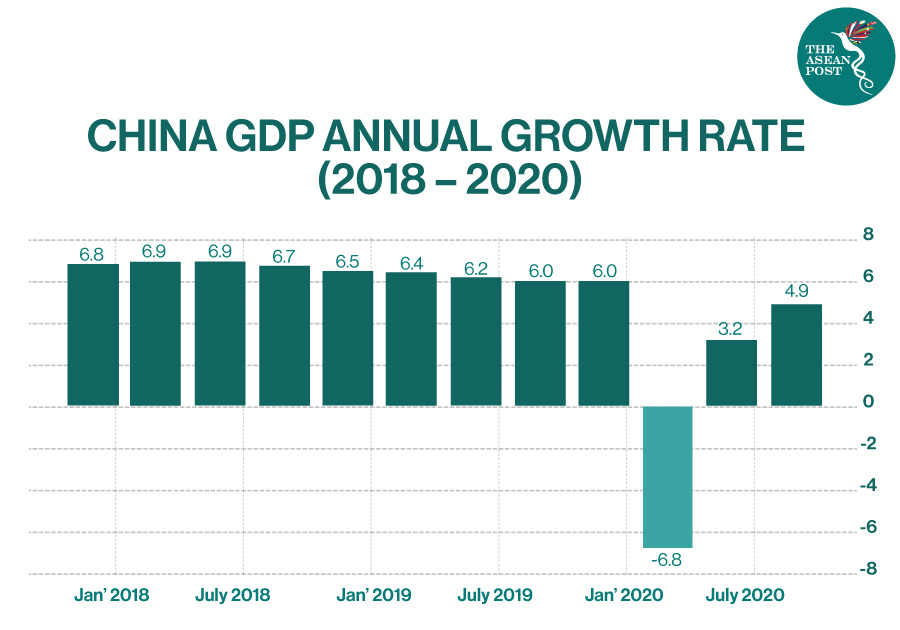The inevitable rise of China as a global power that is increasingly challenging the supremacy and hegemony of the United States (US) both in the Asia Pacific and the world has been one of the dominant issues that has received a great deal of media coverage.
Both locally and internationally, it continuously predominates attention in foreign policy circles and among local and international academics and experts of international relations and global politics.
And in as far this issue is concerned, one of the most relevant questions is whether China would indeed replace the US as the next superpower in the post-pandemic era.
Economic Resiliency
China had conquered the pandemic within its borders. While the whole world including major powers like the US and European nations are still grappling with the pandemic and its adverse impacts, China has already bounced back economically as exemplified by the 4.9 percent gross domestic product (GDP) growth in July-September, which is a reversal of the 6.8 percent contraction during the first quarter of the year and is higher than the 3.2 percent growth of the second quarter.
China also recorded robust growth in foreign trade in September, with exports and imports in US dollar terms rising 9.9 percent and 13.2 percent, respectively compared to 2019. Indeed, the Chinese economy is showing strong economic resilience despite the adverse effects of the pandemic.
According to China's National Bureau of Statistics (NBS), “the overall national economy of China generally speaking is on a continued steady recovery.” Likewise, China’s central bank governor Yi Gang also said that the Chinese economy remains resilient with great potential. He also said that the Chinese economy is expected to expand by about two percent this year.
This economic projection is similar to the September 2020 World Bank forecast that estimates China's economy to grow by two percent this year, up from the one percent projection in June. Whereas the latest International Monetary Fund (IMF) World Economic Outlook states that, China continues to be the only economy in the world to show positive growth in 2020 as its GDP is predicted to expand at 1.9 percent this year and China's growth will accelerate to 8.2 percent next year, while the global contraction is at 4.4 percent.
The IMF also expects the British economy to contract by 9.8 percent, Japan’s economy to decline by 5.3 percent, Brazil and Russia to contract by 5.8 percent and 4.1 percent respectively, India’s economy will shrink by 10.3 percent, while the US economy is expected to contract by 4.3 percent this year.
Indeed, this is the biggest economic decline of the US since World War II and the Great Recession as the country is still grappling with the coronavirus pandemic and its adverse economic impacts. So far, its GDP has plunged 32.9 percent on an annualised basis, following a five percent decline in the first quarter of 2020.
Among G20 member states, China is the only country that has resumed its growth trajectory amid the pandemic, while the rest of the world’s major powers, including the US, are still shrivelling, or on the edge of recession, while still trying to curb the surge of the coronavirus pandemic and its adverse impacts in their respective countries.
Soft Power Projection
Moreover, not only has China neutralised its COVID-19 crisis – which is its greatest advantage over other major powers and is instrumental in its early economic rebound and resiliency – but it is also successfully projecting its soft power globally through the Belt and Road Initiative (BRI). Despite the global pandemic, the BRI is progressing as expected.
The BRI or sometimes referred to as the “New Silk Road”, is one of the most ambitious infrastructure development projects/initiatives ever conceived. Launched in 2013 by President Xi Jinping, it has already expanded extensively over the last six years since its inception. As of April 2020, it includes 138 countries and 30 international organisations.
The BRI stretches not just to China’s immediate neighbours and partner-countries, but extends from East Asia to Europe, to Latin America, and even as far as Africa, which significantly expands China’s economic and political influence.
Furthermore, China is also at the forefront in supporting the beleaguered World Health Organization (WHO) in the global fight against COVID-19, and at the same time championing and backing the cause of climate change in the world. Whereas the US choses to be detached and outside of the WHO’s global fight against the pandemic, and the Paris Climate Agreement, two global issues of great importance.
Aside from being a permanent member of the United Security Council (UNSC), the recent election of some Chinese personalities to United Nations (UN) bodies is also a demonstration of China’s internationalisation. While the US withdrew from being a member of the UN Human Rights Council (UNRC), China together with Russia and Cuba have won seats on the UNRC. The UNRC is the world premiere human rights body.
The recent designation of Chinese Ambassador to Hungary Duan Jielong, a Chinese diplomat who was recently elected as a member of the International Tribunal for the Law of the Sea is another manifestation of China’s increasingly felt presence in the UN.
Duan is one of the six judges to be elected in the first round of voting by the state parties to the United Nations Convention on the Law of the Sea (UNCLOS), tasked with settling maritime disputes. This again is another “smack in the face” of the US. To note, the US has not ratified UNCLOS.
The election of Chinese diplomats to UN bodies is indeed an indication that China’s soft power projections are gaining traction internationally and that the international community is recognising and welcoming China’s presence in the UN. Thus, China’s international influence is growing by the day with the BRI gaining traction together with China’s contributions to global issues of great importance like climate change and the global fight against the coronavirus pandemic.
The US’ failure to lead on these global issues on the other hand, is resulting in the waning and increasing decline of its hegemony and global influence.
Ingenuity & Relative Successes
Over the years, China has gained relative successes in its efforts to continuously uplift its economy and its people to a better standard of living. With its more than 1.4 billion population, China has brought more people out of extreme poverty than any other country in history.
According to the World Bank, more than 850 million Chinese people have been lifted out of extreme poverty. China's poverty rate fell from 88 percent in 1981 to 0.7 percent in 2015, as measured by the percentage of people living on the equivalent of US$1.90 or less per day in 2011 Purchasing Price Parity (PPP) terms.
At the end of 2018, the number of people living below China's national poverty line of 2,300 yuan (US$343) per year (in 2010 constant prices) is 16.6 million which translates to 1.7 percent of the population. China hopes to totally eradicate poverty by 2020.

The IMF World Economic Output 2020, using the PPP as a gauge, exemplified that China’s economy is valued at US$24.2 trillion, while the US economy is worth US$20.8 trillion. This means that China has now overtaken the US as the world's largest economy.
Other factors behind China’s impressive rise as a global superpower include: (a) transforming its economy systematically while maintaining its political structure; (b) developing major cities and rural areas; (c) carrying out massive global/external investments and trade; (d) establishing itself as the world’s leading infrastructure giant; (e) becoming the world largest exporter of goods since 2009 with total exports of US$2.64 trillion in 2019; (f) emerging as the world largest trading country since 2013, a position previously held by the US; (g) becoming the world’s second largest importer, importing goods from 41 countries and regions, compared to the US’ 36; (h) holding approximately 17.7 percent or US$1.9 trillion of the world’s total wealth, the second largest share held by any country in the world; and (i) having major companies that are making a mark amid the pandemic.
Furthermore, as reported by the Credit Suisse Research Institute, China has also overtaken the US in terms of citizens in the global top 10 percent for wealth. To note, in 2019, there were 658 Chinese billionaires and 3.5 million millionaires. Likewise, China has the world’s largest banking sector, with assets amounting to US$40.1 trillion.
Some of the world’s largest banks are in China. The big four state-owned commercial banks are: (1) Bank of China; (2) the China Construction Bank; (3) the Industrial and Commercial Bank of China; and (4) the Agricultural Bank of China. These are among the largest banks in the world as of 2018. Other big banks include the Bank of Communications, the China Merchants Bank and Ping An Bank.
Conclusion
China without a doubt has had a “faster-than-expected recovery” from the coronavirus pandemic. Though there is increasing anxiety among countries about the impending rise of China, nevertheless, China’s increasing economic might and political influence are inevitable.
The US on the other hand, which has dominated the world as a hegemon, nowadays can barely claim “exceptionalism.” To note “exceptionalism” is the perception or belief that a country or society is "exceptional or superior."
Without a doubt, China has consolidated and strengthened its position in economic terms (trade and investment) and as a global player even amid the coronavirus pandemic.
In the post-COVID era, it is most likely China will emerge as the dominant power shepherding the new world order, while the US’ global hegemony and influence precipitously fade away.
Related Articles:

